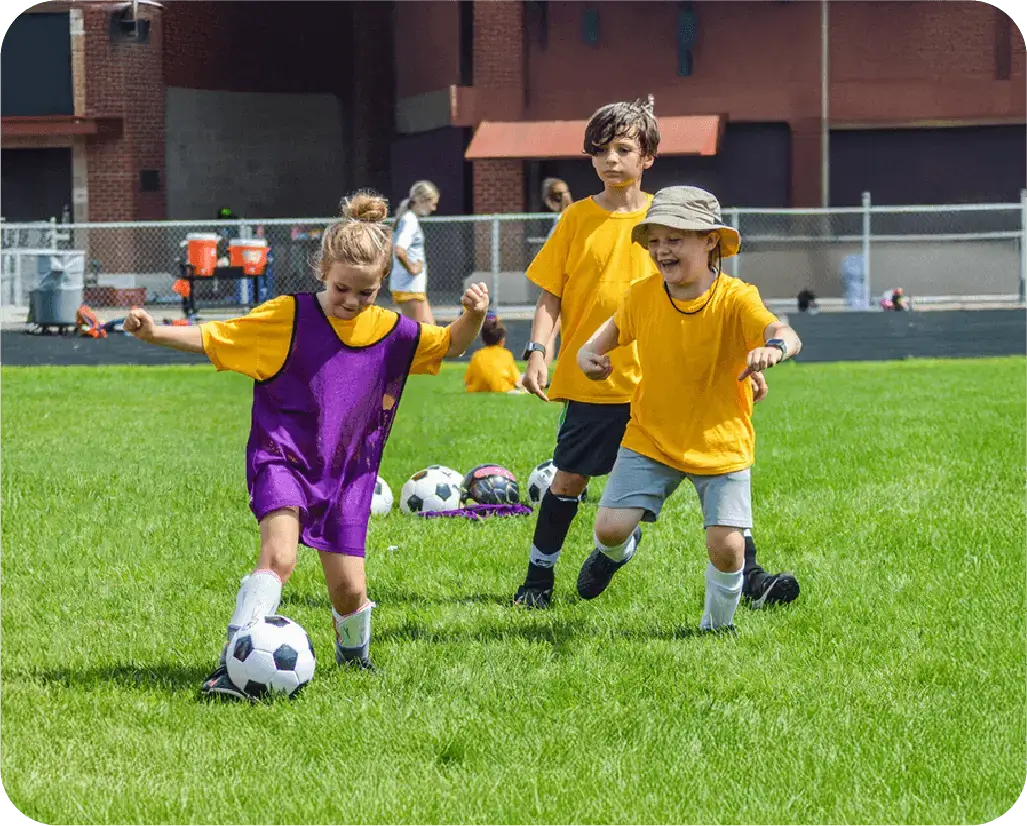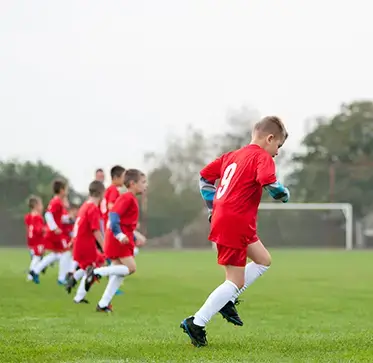CRFC BLOGS
LATEST BLOGS & NEWSLETTERS
A Comprehensive Guide to Youth Soccer Fitness Drills
Youth soccer fitness is vital in enhancing performance, preventing injuries, and promoting overall health. Proper youth soccer fitness training helps young players develop the necessary endurance, agility, speed, and strength required for the sport. This guide covers various types of youth soccer fitness drills, including those with and without the ball, drills suitable for different age groups, and activities that can be performed individually and in large groups.
Dynamic Warm-ups
Dynamic youth soccer warm-ups are essential for preparing muscles and joints for the intense physical activity that soccer demands. Unlike static stretching, dynamic exercises keep the body moving, helping to increase blood flow and reduce the risk of injury. These exercises are a crucial first step in any soccer training session or match, setting the tone for the workout ahead. These dynamic warm-up exercises should be performed for 5-10 minutes before each training session or match to ensure that young players are physically ready and mentally focused.
Light Jogging
This helps gradually increase heart rate and blood flow to the muscles. It’s a simple start that gets the body moving without straining it.
Skipping
Skipping is excellent for coordination and helps warm up the calves and ankles. It adds a fun element to the warm-up and keeps young players engaged.
Side Shuffles
These improve lateral movement, which is essential in soccer for quickly changing directions. They also help warm up the hip flexors and groin muscles.
Carioca
This drill involves crossing one leg over the other while moving sideways. It enhances hip mobility and coordination, which is crucial for swift directional changes in soccer.
High Knee Pulls
This exercise stretches the glutes and hamstrings while also promoting balance. It’s a great way to get the lower body ready for action.
Heel Kicks
Heel kicks stretch the quadriceps and improve flexibility. They also engage the core and lower back muscles.
Straight Leg Marches
These focus on stretching the hamstrings and calves. They are controlled movements that prepare the legs for more intense activity.
Hops
Hopping on both feet or one foot at a time can help balance and coordination. It also activates the calves and ankles.

Core Youth Soccer Fitness Drills
Core youth soccer fitness drills combine fitness training with ball control and game scenarios, making them engaging and effective. These drills help players develop essential skills while improving their physical fitness.
Dribbling and Passing Warm-up Drill
Four-Cone Passing Drill
This drill emphasizes agility and passing accuracy. Players pass the ball between four cones arranged in a square, moving quickly to receive and pass the ball. This drill is an excellent example of youth soccer fitness drills with cones, as it combines speed and precision.
Six-Cone Passing Drill
Building on the four-cone drill, this version adds two more cones, increasing the complexity and requiring players to think and react faster. It’s an advanced drill that enhances fitness and soccer skills.
1v1 Transition Drill
In this drill, two players compete one-on-one, trying to get past each other to score a goal. This drill focuses on speed, agility, and transitions between defense and offense, making it ideal for soccer fitness drills for U12 and 14-year-olds.
1v1 Speed Drill
This high-intensity drill involves sprinting and quick direction changes. Players compete one-on-one, trying to beat each other in speed and agility. It’s an intense youth soccer fitness drill that pushes players to their limits.

Intensive Conditioning Drills
High-intensity interval training (HIIT) is favored for improving both aerobic and anaerobic fitness. These drills are designed to push players to their limits and enhance their conditioning. These youth soccer fitness drills can significantly improve a player’s stamina and resilience on the field.
4-on-4 Touch the Line
In this drill, two teams of four players compete in a small-sided game. The twist is that players must sprint to a designated line after passing the ball before returning to play. This drill encourages quick, repeated sprints and is perfect for youth soccer fitness drills for large groups.
3-on-3 Force Making
Like the 4-on-4 drill, this one involves smaller teams and emphasizes defensive pressure and quick transitions. Players must quickly switch from offense to defense, making it an excellent youth soccer fitness drill for large groups.
On-ball Off-ball Running Drills
This drill combines ball handling with off-ball movement. Players alternate between dribbling the ball and running without it, improving their ball skills and fitness. It’s a versatile drill for youth soccer fitness drills with a ball.
ABC 150s
ABC 150s involve running varied patterns and sprints. Players perform agility drills (A), balance exercises (B), and coordination movements (C) over a distance of 150 yards. This drill enhances overall skills.
12 Minute Run
This endurance drill involves continuous running for 12 minutes. Players aim to cover as much distance as possible, testing and improving their stamina.
Step Jumps
Step jumps focus on explosive power. Players jump onto and off a step or box, enhancing leg strength and power. This drill is handy for building the explosive movements required in soccer.

Agility and Strength Drills
Drills designed to improve quick movements and overall strength are crucial for developing a well-rounded soccer player. These youth soccer agility and strength drills are some of the best youth soccer fitness drills.
Cross-over Lunges
Cross-over lunges involve stepping one leg across the other while performing a lunge. This exercise improves leg strength and balance, which is essential for soccer players.
Agility Dots
Agility dots are marked spots on the ground that players hop between in varied patterns. This drill enhances quick footwork and agility, making it a fun youth soccer fitness drill.
Single-Leg Hops
Single-leg hops focus on building strength and stability one leg at a time. Players hop on one leg over a series of markers, improving balance and power.
Shuttle Run Drills
Shuttle run drills involve sprinting back and forth between set points. This drill improves speed and endurance, making it a tremendous individual youth soccer fitness drill.
50/50 Lap Runs
Players alternate between jogging and sprinting around a field or track in this drill. It combines long-distance and sprint training, enhancing overall fitness.
Ladder Running Drills
Ladder running drills involve running through a ladder laid on the ground. Players perform various footwork patterns, improving agility and coordination. This is an excellent individual youth soccer fitness drill.
Specialized Youth Soccer Fitness Drills
Specialized youth soccer fitness drills are designed for specific needs and environments, making them versatile and adaptable.
Indoor Youth Soccer Fitness Drills
When weather conditions are unfavorable, indoor drills ensure that training can continue. These indoor youth soccer fitness drills adapt outdoor exercises for indoor settings, maintaining intensity and engagement.
Indoor Shuttle Runs
Players run repeatedly over a short distance, focusing on speed and endurance. This drill is easily adaptable to small indoor spaces.
Cone Drills
Cones can be set up in various patterns to practice agility and quick changes in direction. These drills are effective in confined spaces and keep players sharp.
Ladder Drills
Running through a ladder on the ground and performing different footwork patterns can be done indoors. This drill is excellent for improving agility and coordination.
Individual Youth Soccer Fitness Drills
Individual youth soccer fitness drills are perfect for players looking to enhance their skills outside team practice. These drills allow players to work on specific areas of their fitness and technique at their own pace.
Step Jumps
As mentioned earlier, step jumps are great for building explosive power. They can be done anywhere, making them ideal for individual practice.
Ladder Runs
Players can practice footwork and agility on a ladder alone, focusing on improving their speed and coordination.
Agility Dots
Hopping between marked spots in varied patterns can be done alone. This drill helps improve quick footwork and agility.

Practical Implementation
Implementing these youth soccer fitness drills effectively requires careful planning and consideration of the players’ needs and abilities.
Structuring Training Sessions
Each training session should balance fitness and skill development. It should start with dynamic warm-ups, followed by core fitness drills, and finish with conditioning and agility drills. This structure ensures a comprehensive workout.
Monitoring Progress
Regular assessments of players’ fitness levels are crucial. Coaches should track performance in various drills and adjust the intensity accordingly. This helps prevent overtraining and ensures consistent improvement.
Expert Training
Seeking guidance from a youth soccer fitness expert can optimize training routines. Experts can provide personalized advice and ensure that drills are performed correctly and effectively. For young players looking to improve their skills and stay fit, consider enrolling in charlotte soccer summer camp for specialized training during the off-season.
Conclusion
Fitness is the foundation of youth soccer, impacting every aspect of a player’s performance. Integrating these youth soccer fitness drills into regular training routines can help develop a healthy, high-performing team. Coaches and trainers should prioritize fitness to ensure their players are well-prepared for the demands of the game.
FAQs
How can I improve my soccer fitness?
To improve your soccer fitness, focus on a mix of endurance training, agility drills, and strength exercises. Incorporate high-intensity interval training (HIIT) and regular practice of soccer-specific drills to boost your stamina, speed, and overall performance on the field.
What fitness exercises should youth soccer players do?
Youth soccer players should do dynamic warm-ups, agility drills with cones, endurance runs, and strength exercises like lunges and squats. Combining these with soccer-specific drills, such as dribbling and passing exercises, helps build a well-rounded fitness foundation.
What is fitness training in youth soccer?
Fitness training in youth soccer involves exercises and drills designed to improve players’ physical attributes, such as endurance, speed, agility, and strength. It includes various activities, from dynamic warm-ups and agility drills to conditioning exercises and strength training.
How many times should a young soccer player work out?
A young soccer player should aim to work out at least three to four times a week, balancing between fitness training, skill development, and rest. This routine helps ensure continuous improvement without overtraining.
Why is agility necessary in youth soccer?
Agility is crucial in youth soccer because it enables players to change direction quickly and efficiently, maintain balance, and react swiftly during the game. Improved agility enhances overall performance and reduces the risk of injury.

Did you find this useful?



